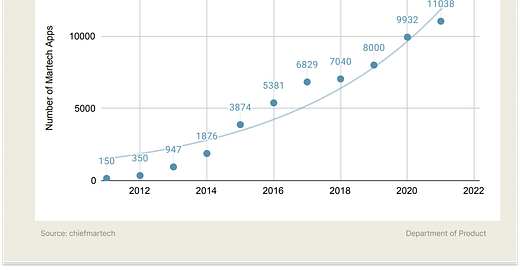📈Chartpack: Product Marketing trends 2023
Important trends worth knowing about and how product teams can stay ahead
🔒Chartpacks are in-depth analysis of the data and trends you need to help you make stronger strategic decisions. If you’d like to unlock your newsletter to receive them you can do so below. Or you can find out more about premium newsletter access here.
Hi product people 👋,
Building a product is one thing, but if nobody knows about it, what’s the point? The lines between product development and product marketing are often very blurred. In some companies, product marketers will work with product managers and UX designers and in others, the marketing department is kept entirely separate (which can often lead to unnecessary conflict).
Regardless of how your company is organized, it's worth staying on top of the latest trends in product marketing so that you fully understand the options for telling people about your product and how those options are evolving over time.
In this Chartpack, we'll explore some of the most important product marketing trends to watch as 2023 comes to a close, including new regulations and their impact on product development.
Coming up:
Macroeconomic climate and its impact on product marketing
Global marketing spend
Key trends to know about:
data and privacy laws
omnichannel experiences
the evolution of customer journeys
generative AI
The future of product marketing: practical steps for product teams and how you can stay ahead
The Macroeconomic climate
It would be fair to say that for tech workers, 2023 has been a year to forget. It was dubbed by Meta CEO Mark Zuckerberg as the “Year of Efficiency” and in reality, for many tech workers that meant one thing only: layoffs.
For the big tech companies themselves, though, the year of efficiency has certainly paid dividends. A year on year comparison shows EBITDA margins for Q3 up significantly.
The efficiency mindset has trickled out of Meta and other tech companies followed suit, too. With interest rates rising, tech companies have been forced to cut costs as they find a path to profitability. Recent IPOs from Arm, Instacart and Klaviyo were a testament to this trend, as all three showed strong unit economics and made the shift to profitability before IPO. Something only 22% of software companies did in 2021.
On a macro level, the US’ GDP is up 4.9%, inflation has dropped from highs of +7% to 3.7% and the NASDAQ in 2023 has outperformed 2022 with rises of +40% year to date vs -33% at the same point last year.
Big tech in product marketing
In the mindset of a product marketer, there’s big tech (Meta, Amazon, Microsoft, Google) and then there’s everyone else. Non-big tech martech companies include the likes of Salesforce, Adobe and Autodesk and recent entrants to the marketing mix also include companies you might not traditionally expect, including Uber and Instacart, who recently added ad platforms to their product stacks.
As we’ve previously noted, Google finds itself in a more strategically fragile position compared to Microsoft, thanks to its over-reliance on search advertising revenues. Over 57% of Google’s revenues are derived from search advertising compared to just 6% of Microsoft.
But despite the economic challenges posed in 2023, global digital ad spend has continued to increase.
In 2023, global digital ad spend reached over 600 billion, up from 550 billion the year prior, with 2024 on track to eclipse this year further.
Key trends to monitor
Aside from the numbers, there are a number of important product marketing trends that have emerged over the past year or so that are worth knowing as a product person.
Let’s take a look at each of them.





